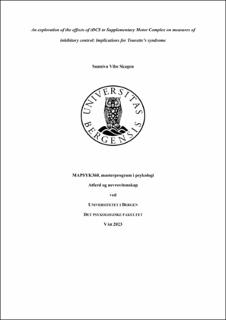An exploration of the effects of tDCS to Supplementary Motor Complex on measures of inhibitory control: Implications for Tourette’s syndrome
Master thesis
Permanent lenke
https://hdl.handle.net/11250/3072128Utgivelsesdato
2023-05-30Metadata
Vis full innførselSamlinger
- Master theses [61]
Sammendrag
Inhibitory control (IC) depends on a cortico-subcortical network, with downstream effects on the primary motor cortex (M1). Hyperexcitability in M1 has been proposed to impair IC, a state associated with tics in patients with Tourette’s syndrome (TS). Anodal Transcranial Direct Current Stimulation (tDCS) applied over the Supplementary Motor Complex (SMC) in order to decrease M1 excitability has improved IC in healthy subjects, while increased tics in patients. In parallel, cathodal tDCS to increase M1 excitability have reduced tics, but impaired IC in healthy adults. Aiming to explore these contradictory findings, we analyzed the effects of anodal, cathodal, and sham tDCS applied to the SMC on measures of IC in young, healthy adults. M1 excitability was monitored with Transcranial Magnetic Stimulation (TMS) and IC was measured from performance on the Anticipatory Response Inhibition Task. The results revealed no change in IC following tDCS. However, we observed a tDCS-induced change in M1 excitability. This suggest that tDCS applied to SMC mainly affects M1 excitability via the cortico-cortical pathway, without engaging the subcortical network important for IC. We also observed an individual response variability to tDCS, showing unreliable directions in excitatory shifts. Overall, we suggest that the puzzling effect on tics following tDCS to SMC could result from direct cortical effects from SMC, not from the involvement of the inhibitory subcortical network. Without undermining the effect of tDCS, we highlight the response variability limiting the methods reliability in the investigation of cognitive abilities and clinical symptoms.
